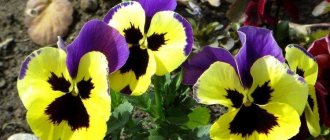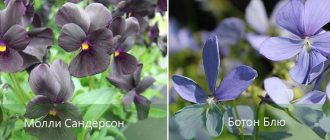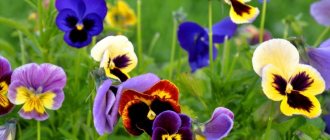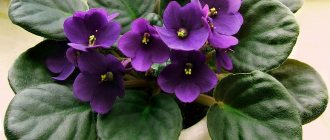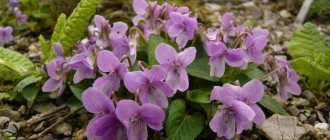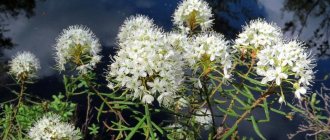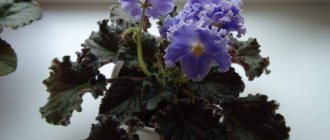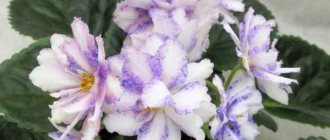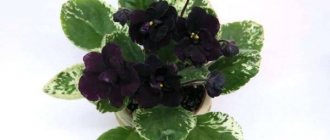Author: Elena N. https://floristics.info/ru/index.php?option=com_contact&view=contact&id=19 Category: Houseplants Published: September 13, 2012Republished: February 12, 2019Last edits: March 19, 2021
These flowers have been familiar to us since childhood. Their shape is unusual, and their colors captivate with the variety of shades of petal color. They are gentle and touching just like their name. This is probably why everyone who grows flowers will definitely find a place in the flower garden for the tricolor violet, which we still, as in childhood, call pansies.
Most popular varieties
Among the pansies that received the greatest popular love are: Freedom, Blueberries with cream, Viola Aurora, Waterfall, Velor, Wittrock Alpensee, Empire, Russian beauties, Evening heat, Ice King, Weiss, Eye of the Tiger, Adonis.
Let's look at each of them in more detail.
Blueberries with cream
This violet is one of the low-growing ones. Its height reaches only 15 cm.
The flower color is dark purple with white edges. This color scheme looks very impressive, which is why such violets are often used to decorate flower beds and borders in urban spaces.
They are also very easy to care for and can withstand low temperatures.
They require loose soil. Planting is done in well-lit areas.
Freedom
This is a small-flowered variety. The diameter of the flowers reaches only 5 cm. The violets fit tightly to each other and grow well. The Freedom variety is unpretentious, frost-resistant and very hardy in the face of adverse weather conditions. It tolerates heat and prolonged downpours better than other representatives of its subspecies (with small flowers).
As a rule, Freedom is grown in combination with other spring flowers.
These violets are not very demanding in terms of care, but they need regular watering and a well-lit place. To ensure denser blooms, it is necessary to remove dried flowers.
Waterfall
This variety is ampelous (violets with long hanging stems), and it is popular in vertical gardening.
This viola is usually grown in hanging pots or containers.
The color scheme of the petals is golden. The size of the flowers reaches 5 cm. It begins to bloom in May and ends in early autumn.
The Waterfall variety is resistant to frost and loves sunlight. The soil under the plant must be constantly moist.
Viola Aurora
This variety is a highly branching compact bush. Reaches a height of 25 cm.
Viola Aurora blooms very profusely. The size of the flower reaches 7 cm. The color of the violet is characterized by variability depending on temperature and lighting.
The viola's petals are corrugated and have a border around the edges. As a rule, it is grown on balconies, but can often be found decorating urban spaces.
Aurora prefers fertile, drained soil. Grows equally well in sun and partial shade.
Wittrock Alpensee
This type of pansy is low. The bushes hardly reach a height of 15 cm.
This violet is unpretentious to conditions, easily tolerating slight drops in temperature. Blooms from May to October, prefers sunny areas and good watering. Most often this variety is grown in balcony containers and garden vases.
Velours
This variety is characterized by small - 20 centimeter bushes with a diameter of about 30 cm. The flowers themselves are small, but due to their close proximity to each other they form a beautiful flower ball. The color is bright and rich.
Velor urgently needs drained soil with high breathability. Grows in both sun and partial shade.
Viola “Velour” is unpretentious and easily tolerates adverse weather conditions. Used as decoration for alpine slides and borders.
Empire style
Refers to a species with large flowers of 10 cm. It is an exclusively decorative variety. Has bright colors. Requires regular and moderate watering.
If conditions are created under which the temperature stays around +16 degrees, then the plant will delight you with very large flowers.
Ice King
This violet grows up to 20 cm in height. The color is white with a slight green tint. The lower petals are decorated with purple spots.
Evening heat
It is appreciated by gardeners as a very beautiful flowering plant. The diameter of the flowers is 5-6 cm, each of which is located on a long peduncle reaching 10 cm.
The flowers are red with a brown tint. Darker spots of the same color can be seen on the petals.
The edges of the petals are wavy. Plant height is 10-15 cm.
Russian beauty
Violets of this variety produce fairly large flowers, reaching a diameter of 8-9 cm.
The bushes themselves are low - about 15 cm. They are unpretentious in care, and can grow even in conditions of a lack of land.
Resistant to cold, grows both in the sun and in the shade.
Weiss
The bush grows up to 25 cm, which is very high for a violet. The flowers reach a diameter of 7 cm.
The color is white with a yellow center. The edges of the petals are wavy.
Adonis
Viola with the fastest and longest flowering. Refers to a species with large flowers. But the bushes themselves are small. The height is only 15 cm. The two upper petals are blue, the lower ones have white and purple spots. As a rule, it is planted in groups.
Tiger's Eye
Medium sized bush. The height, as a rule, is no more than 20 cm. The color scheme is very unusual. Externally, the color resembles a tiger's eye.
It grows into a lush velvet carpet.
The flowers are small in size, 3-4 cm, yellow with textured black stripes.
Tolerates any type of soil provided there is good water permeability and effective drainage.
Types of pansies
Even in the wild, there are several hundred varieties of pansies of all imaginable and unimaginable colors. It’s not for nothing that they are distributed all over the world, from the subtropics to the northern regions!
Fragrant pansies
This species is famous for its aroma and variety of blue and purple shades. It is this viola that is widely used in cosmetology and perfumery.
Photo: 9dach.ru
Horned pansy
A garden perennial that got its name because of the bizarre growth behind the bud. The height of the shoots reaches 25 cm, and the leaves are more elongated. The diameter of the flowers is generally about 5 cm.
Photo: viherkasvit.net
Monochrome pansies
All petals are painted in one uniform color. But veins, small spots or stripes on the lower petal are acceptable. Yellow and snow-white varieties are very popular.
Photo: pxhere.com
Two-color pansies
The most common category among gardeners is when the upper and lower petals are colored differently. It seems that all existing colors are found here.
Photo: pinterest.ru
Spotted pansy
Spots on buds and petals can be of several colors at once. There are decorative varieties with corrugated flowers. An excellent option for shady areas.
Photo: pixabay.com
Sororia
This variety is also called moth viola, and its fancy white and lilac petals really look like the wings of a moth. It is also a perennial with beautiful heart-shaped leaves.
Photo: prolisok.com.ua
Osteospermum (50 photos): types, planting and care in open ground
Planting violas Peculiarities
If you plant pansies without following the rules relating to a particular variety, then you may not expect flowering in the first year.
Planting in the ground should be done only when the seedlings have become strong and fully formed.
As a rule, seedlings are grown at home, starting from late February - early March.
Planting seeds directly depends on the climatic conditions of your region. Therefore, this factor must be taken into account.
Before you start seedlings, study all the information for your region. It happens that some varieties may not be suitable at all for a particular climate zone.
General recommendations:
- Prepare the correct soil.
Pansies do not like acidic soil. Therefore, prepare in advance suitable containers with a slightly acidic soil reaction. The earth needs to be moistened, but without enthusiasm. Subsequently, it is also recommended to ensure that there is no overflow.
Viola seeds are sown in furrows and covered with soil of a small thickness of 4-5 mm.
The small thickness will allow you not to miss the first shoots, which will appear in 4-6 days.
- Monitor the temperature.
Seedlings love cool conditions at temperatures from +17 to +20 C. A few days later, as soon as the first shoots appear, lower the temperature to +13 - +17 C.
- Feed the seedlings.
Fertilizers must be applied during plant growth. You can use an instant fertilizer containing nitrogen, phosphorus and potassium.
- Picking seedlings.
After a short germination, the seedlings must be transplanted into cassettes with a cell diameter of no more than 7 cm.
The timing of the dive depends on the time of appearance of the first two leaves. Not earlier! If there is a need for seating in parts, this is acceptable.
After transplanting, place the finished cassettes with violets in a cool place with a temperature of +10 to +13 C.
As a rule, to ensure such temperature conditions, cassettes with seedlings are placed in a greenhouse. But if you don’t have this opportunity, then a veranda, balcony or window sill will do.
After diving, continue fertilizing following the instructions on the fertilizer package.
- Landing in the ground.
Transplantation of established seedlings is carried out approximately 2 months from the date of first sowing. The timing of the final transplant depends on the variety and condition of the plant.
Plant seedlings at a distance of 10–20 cm from each other, as too close proximity can lead to rotting of the root system and the plant itself.
How to determine whether seedlings are ready for transplanting or not?
As a rule, gardeners look at the number of leaves. On strong, fully formed seedlings there should be at least 4 of them.
In some situations, it is possible to transplant into the ground already at the flowering stage. It's even better for violets.
If everything described above is too complicated for you and is not completely clear, then use garden varieties of tricolor violets.
Such violas do not require intermediate transplantation (diving) into cassettes. Planting in the ground can be done after the first two leaves appear.
Choosing a landing site
It is necessary to plan the place where you plan to plant pansies in advance - even at the stage of choosing a variety.
Some species can grow in the sun and in the shade, and some of them do not like shade at all. But, for the most part, violas prefer well-lit, warm areas. Choose a place where there is sunlight for at least 6 hours a day.
Choose places with shade or partial shade only if the plant variety allows it. During preparatory work, do not add additional fertilizer to the soil. It is enough to choose an area with fertile soil and loosen it well.
Care
If you have chosen the right place, according to the viola variety, and maintain the required level of soil moisture, then the plants will delight you with their lush, beautiful flowering throughout the warm season.
Pansies do not require regular watering. The most important thing is that the soil is always moist. But there shouldn’t be any overflow. That is why, when choosing a landing site, make sure that rainwater does not accumulate or stand there.
If there is a dry spell, water the plants regularly, otherwise they will shrink in size or stop blooming altogether.
Some varieties of viola require additional feeding. If this is necessary for the species you have chosen, then fertilizing the soil only needs to be done twice during the entire season.
Any drugs can be used. The most important thing is that they are suitable for the violets that you plan to breed.
The first feeding is carried out before flowering - during budding. The second is carried out when the violets bloom.
After flowering begins, make sure that there are no weeds, as they can become intermediaries in the transmission of various diseases and infections. Weed regularly.
After flowering ends, when there are practically no leaves left on the plant, cover them with straw, spruce branches, or fallen leaves.
A similar procedure is carried out only for perennial plants. If you planted annual varieties, or varieties that do not require insulation, then there is no need to carry out the procedure.
Carefully study the information about the selected variety.
Pests and diseases
Most often, viola suffers from fungal diseases, but it also happens that pests settle on it:
- Powdery mildew . Whitish spots appear on the bush, which become larger over time. The diseased plant should be dug up and burned. Still healthy bushes are sprayed with a fungicidal preparation.
- Gray rot . Brown-gray spots form on the lower leaf blades. Reduce watering and spray the bushes with a fungicidal agent.
- Black leg . A dark ring appears on the shoot near the surface of the soil. Over time, the stem in this place rots and falls. Young bushes are most susceptible to the disease. Diseased flowers are removed away from healthy ones and sprayed with a fungicidal agent and biological product.
- Spotting . Specks form on different parts of the leaf plate. Over time, it curls and dries out. The diseased plant is removed from the ground and destroyed. The remaining bushes are sprayed with Bordeaux mixture for preventive purposes.
- Clover cutworms or mother of pearl caterpillars . Because of them, holes appear on the foliage. Remove pests mechanically. If there are a large number of them, then spray with tobacco infusion or an insecticidal preparation.
Viola propagation
In addition to planting and care, one more, no less important question remains: how to propagate violets.
There are only 3 possible ways.
Seeds
This method is discussed in great detail in the section on planting seedlings.
Basic moments:
- we plant the seeds in February-March in a container that is located in a warm and bright place;
- We pick up the sprouts two weeks after germination;
- transplant into separate cups, or place in a common container at a distance of up to 5 cm in a checkerboard pattern;
- After 2 months, we transfer the strengthened seedlings to open ground.
Dividing the bush
This method is used extremely rarely. As a rule, it is only suitable for propagating perennial violets.
There are no difficulties in this method. It's simple: one viola bush is divided into two or three inflorescences, then placed in separate holes for further cultivation. When the separated inflorescences feel free, they will grow into full-fledged bushes.
Propagation by cuttings
This propagation option is the most popular, as it can be used for all types of pansies.
For propagation, take green terminal shoots with 2–3 nodes. Cuttings are pruned from May to July. The timing of pruning depends on the specific variety of viola.
The procedure of cuttings and subsequent planting is carried out directly in the garden. The location must be shaded.
All cuttings are planted close to each other to a depth of no more than 0.5 cm.
After planting, the shoots are sprayed and covered with wet paper or newspaper to create more humid conditions. This promotes the fastest growth of the plant.
Propagation by cuttings is best done in warm, dry weather.
Caring for cuttings after planting
After planting, cuttings require daily spraying, weeding and fertilizer.
If everything is done correctly, then within a month the violet shoots will acquire their own new root system.
If you carry out the propagation procedure at the beginning of the summer season, then in the fall you can plant pansies in ready-made flower beds.
If the cuttings were carried out later, it would be correct to leave the new seedlings until spring, covering the planting site with denser material. Plywood works great.
Among the advantages of propagation in this way, I would like to note that in this way the violets are significantly rejuvenated. Already in the 3rd season, new flowers are able to grow into enormous force.
Unpretentiousness of the flower
My sister has been trying to grow these flowers in her flowerbed for several years now, but every year they fade, leaving no “offspring.”
I bought pansy seedlings and planted them, admired them enough and didn’t even hope to see them next spring. Imagine my surprise when the next year the violets sprouted on their own as a result of self-seeding. A year later they grew to cover the entire flower garden. And we are not talking about some simple flowers, but about Dutch selection violets, the so-called technical specimens, which are considered sterile.
My sister and I's plots are located nearby, and the soil on them is the same. And what should I tell my sister, who plants pansies year after year, cares for them, waters them, feeds them and experiences the same disappointment every spring?
Medicinal properties of violas
Pansies have long been used in folk medicine.
Tricolor violet has the following beneficial properties: anti-inflammatory, antiseptic, bronchodilator and expectorant, choleretic, antispasmodic.
Violets are used both in pure form and in the form of decoctions and infusions.
Pansies – photo
Thanks to their fancy color, pansies always look fabulous and exotic. It's hard to believe that they are actually completely simple and unpretentious. Look how good they are in group plantings!
Photo: m.2gis.ru
Photo: wallbox.ru
Photo: m.fotostrana.ru Photo: wallpapers.net
Photo: nevseoboi.com.ua Photo: wallbox.ru
Photo: cvetyphoto.blogspot.com
Photo: tchudesa.ru
Photo: fotoload.ru
Photo: pxhere.com
Photo: zastavki.com
Photo: vaseninasu.blogspot.com
Photo: kartinki-cvetov.ru
Photo: pixabay.com Photo: ru.wallpaper.mob.org
Photo: funart.pro Photo: eldomo.ru
Photo: plodovie.ru
Photo: nat-geo.ru Photo: zen.yandex.by
Photo: funart.pro
Photo: proprikol.ru
Photo: cvetkoffandbuketoff.ru
Photo: wallbox.ru
Did you like the post? Subscribe to our channel in Yandex.Zen, it really helps us in our development!
ethnoscience
From time immemorial, brothers have been respected as a miraculous and medicinal culture. The ancient Greeks insisted on violet wine; such a drink adds elation, courage and protects against evil. Slavic healers have long recommended drinking tea made from dried flowers to relieve heart pain. Brothers collected in the field will dull toothache, ease scrofula, cough, and restrain the growth of hernias and other diseases. Most of all, violet saves children from colds, coughs, and allergic inflammations.
As a medicine, brats are used both independently and in herbal preparations.
To get rid of cystitis, pyelonephritis, and kidney stones, the culture is combined with hop cones and lingonberry leaves.
For the treatment of non-healing eczema and psoriasis, it is mixed with yarrow, smokeweed, nightshade, wild rosemary and hoofweed.
To cure scrofula and diathesis, the flowers are mixed with string, chamomile and nightshade. This collection is called Averin tea.
Fresh juice is used to treat spots and pimples with impetigo, herpes, purulent pimples, ulcers in the mouth and genitals.
Violet tea stimulates the kidneys, it causes additional sweating and cleanses the blood; it is drunk for rheumatism, rickets, gout, arthritis, and rheumatism.
Herbal tincture effectively fights colds and coughs. This product performed best in treating children's coughs and colds.
The herb infused with a 9% vinegar solution will relieve the disgusting headache of migraine.
Bratchik tea is popularly used to cleanse the blood of sexually transmitted infections. After drinking this tea, urine acquires a peculiar aroma.
Dog violet
In May, on forest edges, in thickets of bushes, under the canopy of sparse forests, and even in open places - meadows, fields, along the banks of reservoirs - the dog violet (Viola canina) blooms.
Dog violet in a sparse forest
Why they called her that - I don’t know, sorry! It is clear that this is a literal translation into Russian of the Latin name. The plant is not too noticeable, but interesting. The flower, like other violets, is five-membered. But the petals are already one color, mostly pale blue. There may be several of them on one stem, on long peduncles. The leaves of the dog violet are stem, alternate, on cuttings. Basal leaves appear only after flowering.
Like many spring-blooming plants, dog violet is a myrmecophilous plant. Indeed, ants (“myrmekos” in Greek) take the most active part in the distribution of its seeds. In June, fruit boxes already ripen in place of the flowers. The ripe fruit cracks, its leaves curl, scattering the seeds. But each seed is also equipped with a special body to attract ants, like lungwort, liverwort or corydalis. Ants take away the seeds, and they can spread quite far.
But I still can’t pinpoint this violet!
Swamp violet?
Quite large leaves in a basal rosette, heart-shaped at the base. Single pale blue flower. Grows in spruce-birch forest on fairly moist soils. I looked through several determinants, but I’m not completely sure...
For an accurate identification, for that matter, the plant had to be picked or dug up in order to carefully study its structure. I just took a photo and can tell from the photo.
Most likely, this is the marsh violet (Viola palustris).
Interesting fact
It is curious that in some types of violets the first spring flowers often do not form fruits. This may be due to the lack of pollinating insects at this time. And later they have other, inconspicuous flowers, more like unopened buds. Self-pollination occurs in them, and after this fruits and seeds are formed.
the amazing violet (Viola mirabilis) is named so. In spring, it forms a rosette of large basal leaves, and a beautiful but sterile flower grows on a long peduncle. And in the summer, a rather tall stem with leaves and flowers - “buds” - is formed.
Violet is amazing. Spring Flower. (Photo from the Internet)
Sowing seeds
Pansies are heat-loving plants. They grow well only in sunny areas. The soil is preferably loose, moist and nutritious. It is better that it is drained with an average level of acidity.
Interesting!
In sunny areas, pansies always produce large and bright flowers, but the flowering itself does not last long. But in dark places the opposite is true.
Planting is carried out at different times of the year - it depends on the climate and the desired flowering period. In view of this, there are two methods of growing crops: seeds and seedlings. First, it’s worth describing the most popular method - seeds.
In this case, violas are sown in prepared soil around the end of July. The soil should combine equal amounts of peat, humus, garden soil and sand. Shoots appear in about 2 weeks. And at the end of summer, the resulting shoots are transplanted to a permanent place with a distance between individual shoots of 10-30 cm.
6. Application in landscape design
Pansies will be a very bright decoration of any flower bed. Thanks to the very long flowering, you can get a flowering border by planting plants along garden paths.
Viola is the foreground flower that catches the eye. You should not plant this species in the center of a flower bed or flower garden, where it can get lost among tall plants.
↑ Up,
